The Salimbeni Prize is awarded by the Fondazione Salimbeni per le Arti Figurative of San Severino Marche to honour excellence in the writing of art history on an Italian subject. The Premio Salimbeni was established in 1983.

The Basilica dei Santi Giovanni e Paolo, known in Venetian as San Zanipolo, is a church in the Castello sestiere of Venice, Italy.
The decade of the 1450s in art involved many significant events, especially in sculpture.

The Pieve of Saint Syrus is a church in the village of Cemmo, a frazione of Capo di Ponte, at 410 meters above sea level. It was one of the pievi, or isolated churches with baptistries, among which the territory of Val Camonica was divided. The complex, which stands on a ridge overlooking the river Oglio, can be reached via a staircase built in the 1930s.

Santa Maria Assunta is a church in the north-west of Esine, in the province of Brescia, northern Italy, listed as national monument.

Cecco di Pietro was an Italian painter of the Pisan School. While his date of birth cannot be confirmed, there is some mention of a Cecco Pierri working with the painter Paolo di Lazzarino in 1350. If this was a reference to di Pietro, then his date of birth can be placed around 1330.

The church of Santi Severino e Sossio and the annexed monastery are located on via Bartolommeo Capasso in Naples, Italy.

The Chapel of Saint Thomas of Villanova and the Chapel of Saint Rita are two small chapels opening in the right transept of the Basilica of Santa Maria del Popolo. They are relatively insignificant in terms of artistic value compared to the other side chapels of the church.
Domenico Mancini was an Italian painter of the Venetian mainland, painting in a High Renaissance style. Mancini was either a pupil or a close follower of Giorgione and Giovanni Bellini. He is said to have worked alongside Pietro Maria Pennacchi.

Salomé is an oil painting on canvas, by Moretto da Brescia, executed c. 1540. It is kept in the collection of the Pinacoteca Tosio Martinengo in Brescia.
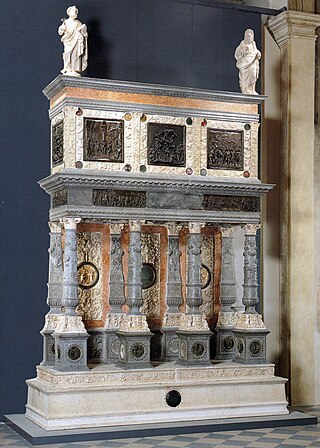
Bernardino delle Croci was an Italian goldsmith and sculptor of the Brescian Renaissance. He was the founder of the Delle Croci family of important goldsmiths and sculptors, known for their specialism in processional crosses, reliquaries and altars.

Supper in the House of Simon the Pharisee is a 1544 oil on canvas painting by Moretto da Brescia, now in the Chiesa della Pietà in Venice, Italy.
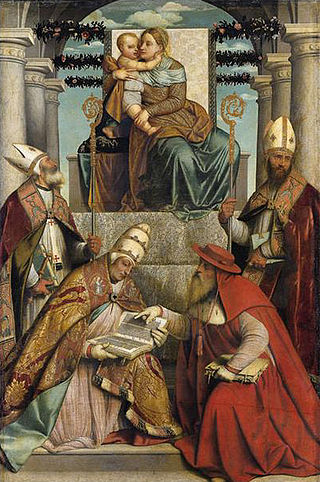
Madonna and Child with Four Doctors of the Church is a 1540-1545 oil on canvas painting by Moretto da Brescia, now in the Städelsches Kunstinstitut in Frankfurt. From left to right it shows Saint Ambrose, Gregory the Great, Saint Jerome and Augustine of Hippo.
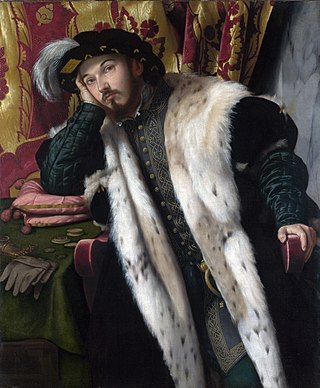
Portrait of Fortunato Martinengo Cesaresco is a 1542 oil on canvas painting by Moretto da Brescia, now in the National Gallery, London. The use of X-ray photography during a 1973 restoration showed a table in front of the man with an open book on it.

St Anthony of Padua with Two Saints is a c.1530 oil on canvas painting by Moretto da Brescia, now in the Pinacoteca Tosio Martinengo in Brescia. The other two saints shown are Antony the Great and Nicholas of Tolentino.

Giovanni Pietro Toesca was an Italian academic and art historian, notable as one of the most important historians of medieval to 20th century art. His La pittura e la miniatura nella Lombardia fino alla metà del Quattrocento was the first attempt to reconstruct the course of figurative Lombard art from the Middle Ages onwards, defining its importance across Europe.
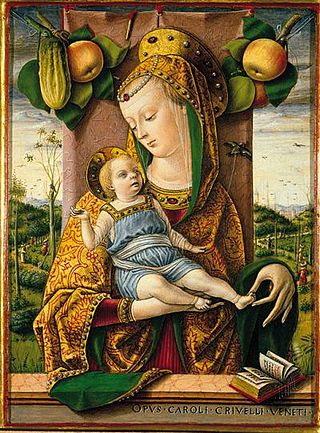
Madonna and Child is a tempera and gold on panel painting by Carlo Crivelli, executed c. 1480, and signed OPVS CAROLI CRIVELLI VENETI. It is now in the Pinacoteca civica Francesco Podesti in Ancona. Its dating has varied on stylistic grounds between the 1470s and 1480s, close in date to the artist's Lenti Madonna and Madonna and Child with an Apple.
Giuseppe Fiocco was an Italian art historian, art critic, and academic. He is known for his research and writings on Venetian and Florentine artists.
This is an alphabetical index of people, places, things, and concepts related to or originating from the Republic of Venice. Feel free to add more, and create missing pages.
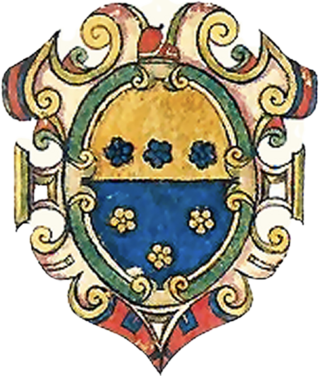
The House of Loredan-Santa Maria is a cadet branch of the noble House of Loredan which has produced many politicians, diplomats, military generals, naval captains, church dignitaries, writers and lawyers, and has played a significant role in the creation of modern opera with the Accademia degli Incogniti, also called the Loredanian Academy. The branch draws its name from the parishes of Santa Maria Formosa and Santa Maria dei Miracoli in Venice, around which it was historically settled. The progenitor of the branch is considered to be the famous admiral and procurator Pietro Loredan (1372-1438) by his sons Giacomo and Polo.
















